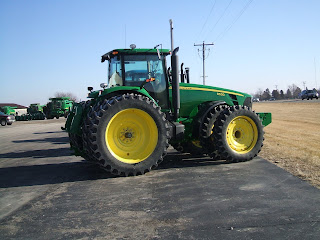Each year we chop earlage to fill the silos here on the farm.
from Greg Lardy, a North Dakota State University Extension Service beef specialist,
Earlage, which is ensiled corn grain, cobs, and in some cases husks, is higher in energy than corn silage with similar protein content. It’s lower in energy than corn grain because it includes the husk and cob, but it works well in a variety of cattle diets, including growing and finishing diets for beef cattle and feed for lactating dairy cows,
The chopper is a John Deere 5820. I think the hp rating is in the 325 range, I'm not certain. This particular chopper was sold new in Germany. A business in Minnesota imported the used machine, (came over on a ship). My understanding was the shipping costs were less than 2500 dollars.
In the first video if you look closely you can see the speed hitch system we use. It automatically hitches the forage wagon to the pulling implement.
Next we drive alongside the chopper and the forage box it is pulling. The chopper has a regular corn head which strips the ears of corn off of the plants, then the ears flow back to a drum with 48 knives on it, (about 3 inches long, razor sharp,) which cut the ears of corn into pieces which must pass through the holes in a 3/4 inch screen. The chopped ear corn then passes into a blower, (literally a giant fan with paddles on it) which throw the corn out of the machine into the wagon.
After the corn is chopped into the wagon it is hauled to the silo. There it is fed into another blower which blows it all the way to the top of a seventy foot silo. The blower spins at 1000 rpm. Laying horizontal to the ground at the bottom of the blower is a spinning disk with small paddles on it, which throws the earlage into the moving paddles of the blower.(Think throwing something into the moving blades of a fan.)
We completed chopping corn, almost exactly a month later than normal, blame it on global climate change or something, the crop was simply far behind normal in maturing. The rest of harvest is going just as slow or worse. The crop is not drying down naturally, we have had abnormal amounts of rain, and cold weather.
Many years the entire harvest is done by the second week of November. At the rate it's going now, we will not be done till some time in December.
Thursday, October 22, 2009
Chopping Earlage
Posted by
farmer Tom
at
8:13 PM
|
![]()
Subscribe to:
Comment Feed (RSS)


